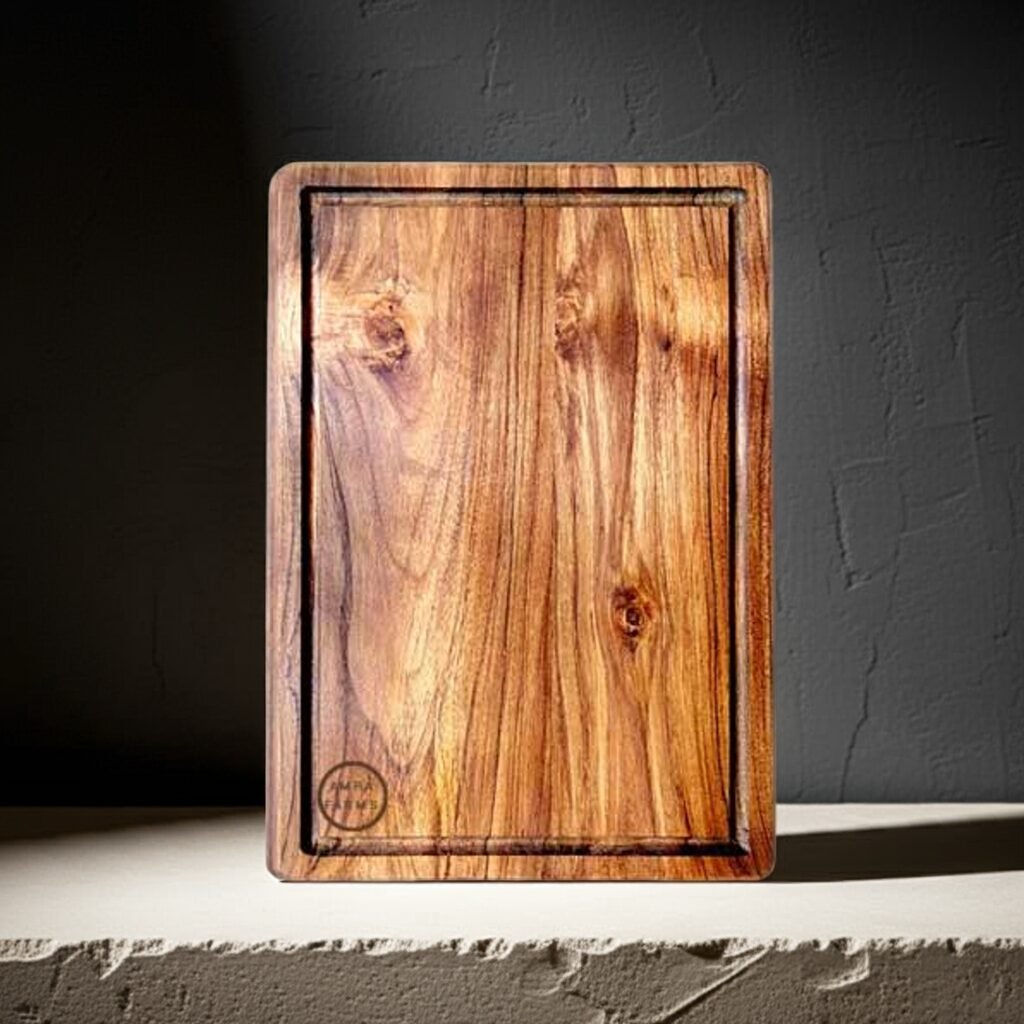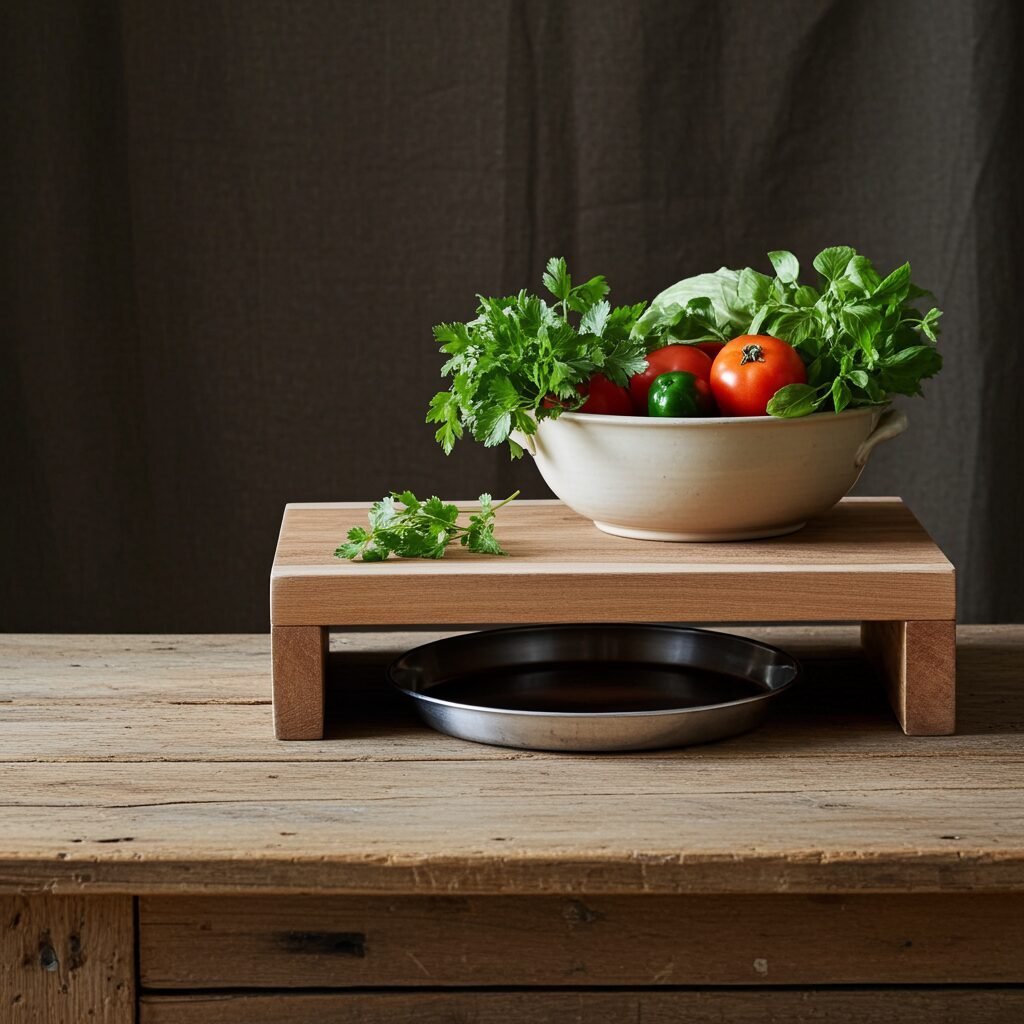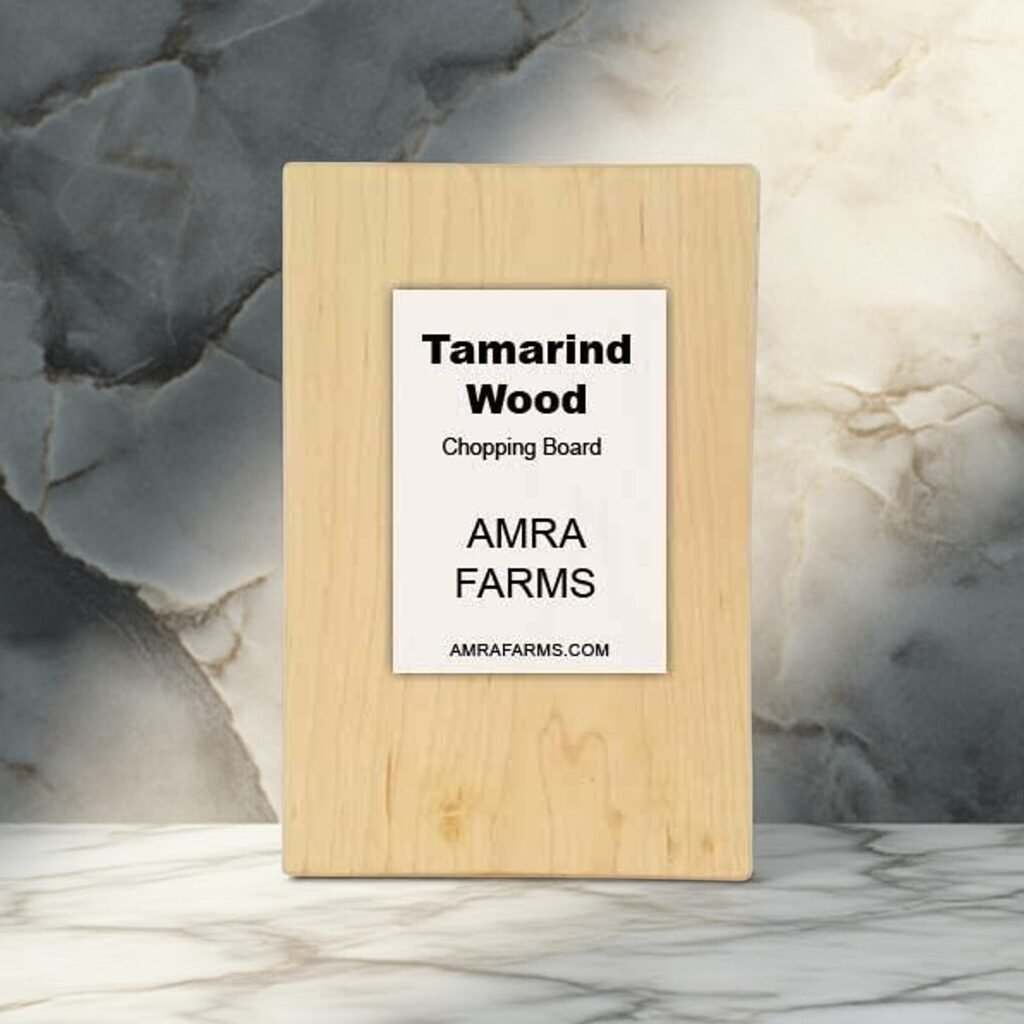Your cart is currently empty!
Best Wood for Chopping Board : Types of wood used for cutting boards in India
Types of Wood Used for Cutting Boards in India
Cutting boards are an essential in Indian kitchen. Traditionally, people from each part of the country have used wood which was locally available. The southern part of India mostly used Tamarind wood, Teak and Neem. The northern part of India used Acacia, Mango and Teak. Some areas used Maple where available and others used just about any wood which was locally available and food safe. Traditional Indian home cooks never worried about knife friendliness or eco-friendliness, but were more concerned about food safety and durability. Each cutting board had to be durable and safe to use.






In the recent years though, with many living in the city with limited to no access to wood, and of course the popularity of other materials, plastic, bamboo, steel and glass made its way into Indian kitchen. Hardwood is not only hard to find, but many homemakers have forgotten the aesthetics, benefits and durability of a wooden cutting board.
Hardwood like Teak, Neem and Tamarind were known for their durability but was more importantly known for being food safe. The closed grain structure of a board resisted bacteria, making it the preferred material for chopping meat. Wood is also naturally antibacterial with its natural oils (which of course was recently proven in research).
When it comes to the best wood for Indian kitchens? It has always been Teak. Teak is a food safe wooden board. It is durable, beautiful and one of the few prized possessions in an Indian kitchen.
Why Wood is Preferred Over Plastic or Glass
Naturally antibacterial
The inherent antibacterial properties of wood make it a perfect candidate for cutting boards. Salmonella, E. coli and other bacteria die off much faster on a wooden board than on a steel, plastic or bamboo board. Wooden surface, though porous, traps bacteria and the natural oil in the wood deprives bacteria of the environment needed for them to grow.
Gentler on Knives: Unlike glass, plastic and steel, wood is less abrasive and softer. This makes it gentler on the knife blades and preserves the knives’ sharpness, reducing the need to frequently sharpen them. Boards like glass and steel are also dangerous when used with brittle knives, causing them to chip.
Sustainable & biodegradable options: Wood is natural and biodegradable. Plastic, on the other hand, contributes to environmental pollution. Steel, glass and bamboo are relatively more sustainable options but plastic is often a material which leaves a carbon footprint during production.
| Feature | Wooden Board | Plastic Board |
|---|---|---|
| Hygiene | Natural antibacterial properties | Bacteria can hide in scratches |
| Knife Care | Gentle on blades | Can dull knives faster |
| Durability | Long-lasting; can be sanded | Prone to warping and damage |
| Eco-Friendliness | Renewable and biodegradable | Non-biodegradable |
| Maintenance | Requires oiling and care | Easy to clean but less durable |
Popular Types of Wood Used for Cutting Boards in India
Neem Wood Cutting Board
Naturally antibacterial, anti-fungal, resistant to pests like termites and borers, Neem wood is one of the most preferred materials for cutting boards. It’s also traditionally used in Ayurveda and is known for its healing properties.
Advantages: Neem is eco-friendly, biodegradable and non-toxic. The wood is antibacterial and a food safe option. It is hard to handle cuts and chops, if constructed well and has a good thickness.
Disadvantages: Requires very good care and maintenance. Is prone to cracking without maintenance and is short-lived if not oiled frequently. Prone to warping if the wood is exposed to excessive humidity and is not water resistant.
Neem is a popular wood in southern part of India, including Kerala, Tamil Nadu, Andhra Pradesh and Karnataka.
Tamarind Wood for Chopping Boards
Tamarind wood is considered a durable hardwood of 2690 lbf. Considered a luxury material in many parts of the world, tamarind wood is widely available in India, more so in southern parts of India. The toughness of the wood makes it a preferred material for chopping boards. They do not have any specific odour and are non-toxic. Used widely during olden times for chopping vegetables, commercial butchers still use tamarind as their preferred material for butcher blocks. Spalted tamarind is considered prized material and is often more expensive than normal tamarind wood.
Advantages: Tamarind is easy to acquire and is sustainably sourced. The wood is tough, heavy-duty and affordable. Considered durable to very durable when it comes to decay and resistance to insect attack.
Disadvantages: Tamarind wood is considered hard to work with. They have a pronounced blunting effect but have a great finish and are able to take oil content well.
In general, tamarind wood is a time-tested wood used for chopping vegetables and meat since centuries in India. The ability to acquire tamarind wood, its affordability and sustainability makes tamarind wood one of the most common materials used in Indian households for chopping boards.
Sheesham (Indian Rosewood) cutting boards : Dark Cutting Board
Sheesham is a beautiful dark wood known for its beautiful grain patterns, mostly grown in northern part of India. They are naturally resistant to dry termite attack and have good antibacterial properties. It is used in furniture industry, is durable and eco-friendly. Also known as Indian rosewood, Sheesham has a darker shade and is easy to work with.
Advantages: Relatively cheap wood, grows fast and is eco-friendly, and sustainable. The wood itself is very durable making it perfect for a cutting board. They are antibacterial and anti-fungal.
Disadvantages: Requires care and is prone to warping and cracking if not cared for. Not water resistant and humidity resistant, making it good for northern part of India but not in other parts where humidity is high. Requires regular oiling. Always keep your Sheesham boards dry.
Sheesham is only popular in northern part of the country. Mostly in Rajasthan, Madhya Pradesh, Gujarat and parts of UP. The wood is not a product suitable for southern India where humidity is high. Also, Sheesham is not grown widely in southern part of the country.
Teak Wood cutting Boards – Best Antibacterial Boards
Teak is one of the most priced and prized woods in the list. Teak wood is known for its durability, water resistance and beauty. A heavy-duty wood, Teak wood cutting boards often weigh a lot more than many other woods in the list, often double. The high natural oil content coupled with closed grain fibres makes it water resistant, antibacterial, and rot resistant. Teak is also one of the most durable woods in the list. It’s one of the few woods used to make furniture and construction and even boat building.
Advantages: They are antibacterial, food safe, durable, self-healing, water resistant, and practically indestructible as a cutting board. Heavy duty and with the beautiful aesthetics makes Teak wood the best option for cutting boards and trays.
Disadvantage: These are heavy-duty boards and are often heavy too. They are also more expensive than most other woods.
Teak wood is one of the few popular woods which is used all over the country. Teak is also widely available in the country. Either sourced locally or from other parts for furniture, Teak has been a common wood in most houses for cutting boards.
Mango Wood Chopping boards
A lightweight budget-friendly wood which is affordable and just does the job. Not very popular for furniture, Mango wood is popular in the use for construction. They are not as durable as most other woods in the list but durable enough for cutting boards. Naturally antibacterial, the wood is not water resistant compared to Teak. They are known for their unique patterns and their rustic look which is becoming famous.
Advantages: Very affordable and light. The perfect wood for daily-use cutting boards. They are not heavy-duty and are great cutting boards for vegetables. Moderate maintenance and does not require special care. Oil the boards weekly, keep them dry and away from heat or direct sunlight and the board will last 5 years.
Disadvantages: Mango wood is not great for humid areas. Chances of mould is high if left wet for long. They are also known to warp if the thickness is less than 1 inch.
Mango wood is a safe and cheap option for a cutting board. Though they will cost anywhere between 500 and 1000 Rs in India, most of the cost goes in for crafting the wood and the quality of the wood itself. Single wood / Single block Mango woods are slightly more expensive than chopping boards that are constructed from multiple pieces of wood and joined together.
Acacia Wood Chopping boards
Acacia wood is often passed off as cheap Teak. They look beautiful and have great grain patterns. They are dark and rich, perfect for furniture. Durable but requires care and maintenance. Available widely in northern parts of India and cultivated for its wood. Eco-friendly and sustainable option for cutting boards.
Advantages: Acacia is cheap and readily available. They are beautiful and have a richness. They are dense and scratch resistant.
Disadvantages: Prone to shearing, Acacia requires maintenance and care. They are prone to cracking and warping if left without maintenance.
Acacia is a popular wood in the northern part of India. Mostly grown in Kerala, Tamil Nadu, West Bengal, Rajasthan, Gujarat and Karnataka, Acacia has more than 40 varieties grown in India. It is often sold as adulterated Teak wood. Acacia wood is not suitable for outdoor construction and will warp and crack.
Bamboo Chopping Boards
Bamboo was never used as a cutting board in India till recently. Being eco-friendly and sustainable, there are little options to use Bamboo in a country where an abundance of it is found. Did you know India is the second-largest producer of Bamboo in the world after China!
Advantages: Bamboo cutting boards are tough, affordable, lightweight. They are easy to care for and require relatively the same maintenance as a wooden cutting board.
Disadvantage: Is porous and can cause mould. They are not as water resistant as wood and may absorb water causing it to warp or crack if not cared for. The biggest concern of Bamboo cutting boards is the process in which they are manufactured commercially. They involve joining pieces of bamboo with glue which may be toxic.
Bamboo is a great material for cutting boards. They may not be knife friendly but they are durable, lightweight and eco-friendly. If they are constructed from a reliable source, it’s a great option for an Indian kitchen which we definitely recommend.
| State | Common Wood Types for Chopping Boards | Notable Features |
|---|---|---|
| Kerala | Teak, Mango, Jackfruit, Rubberwood | Teak is premium, jackfruit is durable, rubberwood is affordable. |
| Tamil Nadu | Teak, Mango, Neem | Mango is eco-friendly, neem has antibacterial properties. |
| Karnataka | Teak, Rosewood, Acacia | Teak is widely grown, rosewood is hard and durable. |
| Maharashtra | Teak, Mango, Bamboo | Teak (Burma and Maharashtra grown), bamboo is budget option. |
| Gujarat | Teak, Babool (Acacia), Bamboo | Babool is dense and affordable. |
| Uttar Pradesh | Mango, Neem, Sheesham (Indian Rosewood) | Sheesham is valued for hardness, neem for hygiene. |
| West Bengal | Mango, Jackfruit, Sal | Sal is resilient, jackfruit is locally available. |
| Rajasthan | Acacia, Babool, Sheesham | Local acacia and babool used for budget boards. |
| Punjab/Haryana | Sheesham, Mango, Acacia | Sheesham widespread in Punjab, acacia for price-sensitive buyers. |
| Andhra Pradesh | Teak, Mango, Neem | Mango is a by-product of fruit industry. |
| Odisha | Sal, Mango, Teak | Sal prized for toughness, mango for affordability. |
| Madhya Pradesh | Teak, Sal, Bamboo | Large teak forests, bamboo is emerging. |
| Assam/Northeast | Bamboo, Teak, Gamari (Gmelina arborea) | Bamboo is traditional, gamari is light yet durable. |
Buying Guide: How to Choose the Right Wooden Board
When choosing a cutting board, you should consider several factors including the food you cook, thickness, grain patterns, price, durability, and aesthetics. You want a board which is right for your food type, looks good in your kitchen, and something durable.
Meat vs Vegetable Cutting Boards
If you are a vegetarian or intend to cut only vegetables, we recommend a lighter board. Mango wood is perfect for cutting vegetables. Acacia is an option if you love darker shades and more grains. For cutting meat, poultry, and fish, we recommend a wood which is more resistant to moisture, durable, and a hardwood. Teak is the most preferred wood, with sheesham being the next best preference.
If you are looking for chopping boards for both meat and veges, we recommend a double-sided teak wood cutting board where one side can be used for meat and the other for vegetables.
Thickness and Grain Pattern
Always go for a cutting board that is thick to prevent warping and cracking. Mango wood, acacia, and sheesham should be at least 1.25 inches thick. While teak wood is resistant to cracking and warping, do not buy a teak wood cutting board if it’s less than 2 centimetres.
Price vs Durability
Wooden boards are hard to judge when it comes to prices. You can go from cheap wood like bamboo at 300 Rs to mediocre boards made from mango for 750 to a high-grade teak wood which goes for 3000. The quality of the wood determines the price of the product in each case, and quality influences the price directly too.
| Type of Wood | Features | Price Range (INR) |
|---|---|---|
| Neem Wood | Antibacterial, eco-friendly | 800 – 1,500 |
| Sheesham | Durable, beautiful grain | 1,200 – 2,500 |
| Teak Wood | Water-resistant, premium feel | 1,500 – 3,000 |
| Mango Wood | Sustainable, budget-friendly | 600 – 1,200 |
| Acacia Wood | Scratch-resistant, imported | 1,000 – 2,000 |
| Bamboo | Eco-friendly, lightweight | 400 – 800 |
Categories
Products
- Buy Wooden Vegetable Cutting Boards Online
- Wooden Kitchen Accessories Tools
- Buy Butcher Block & Meat Cutting Boards Online
- Buy Premium Edge Grain Single Block Wooden Chopping Boards Online
- Buy The Best Teak Wood Chopping Boards Online In India
- Buy Wooden Cutting Boards With Handle For Kitchen
- Mango Wood Chopping Boards
- Single Block Chopping Boards
- Tamarind Wood Chopping Boards
- Wooden Platter Boards , Pizza Platters & Charcuterie Boards
Tamarind Wood Cutting Board Teak Wood Cutting board
